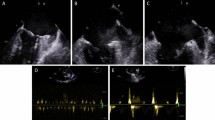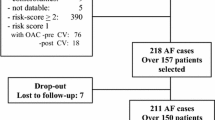Abstract
The Assessment of Cardioversion Using Transesophageal Echocardiography (ACUTE) trial was the first randomized prospective study to compare the conventional strategy of 3 weeks of anticoagulation before direct current cardioversion (DCC) for atrial fibrillation (AF) to a transesophageal echocardiography (TEE) guided approach with an expedited course of anticoagulation. This was a multicenter, international study with 70 sites enrolling 1222 patients between 1994–1999. The primary endpoint of composite embolic events and secondary endpoints including bleeding, functional status, prevalence of sinus rhythm, and death were assessed at 8 weeks following randomization.
The ACUTE trial demonstrated that the TEE guided approach was safe and effective. There was no difference in the primary outcome of embolic events for the 2 strategies (0.8% TEE group vs. 0.5% conventional group, p = .50). There was a difference between the groups with respect to the number of bleeding events, with minor and major bleeding seen in 2.9% of patients in the TEE guided group and 5.5% in the conventional group (relative risk 0.53, 95% confidence interval 0.30–0.93, p = 0.03). The remaining secondary endpoints did not differ.
Clinicians now have a viable alternative approach to cardioversion for patients with AF. Several factors influence the choice of strategies including (1) severity of symptoms and hemodynamic effect; (2) level and chronicity of anticoagulation; (3) risks of bleeding; (4) duration of AF and likelihood of reversion; and (5) risk and likelihood of left atrial thrombi. Future studies, such as ACUTE II are ongoing, with the aim of using low molecular weight heparin to further streamline the TEE guided approach to DCC and shorten hospital stay and costs.
Similar content being viewed by others
References
The Atrial fibrillation follow-up investigation of rhythm management (AFFIRM) investigators. A comparison of rate control and rhythm control in patients with atrial fibrillation. N Engl J Med 2002;347:1825–1833.
Pappone C, Rosanio S, Oreto G, Tocchi M, Gugliotta F, Vicedomini G, Salvati A, Dicandia C, Mazzone P, Santinelli V, Gulletta S, Chierchia S. Circumferential radiofrequency ablation of pulmonary vein ostia:Anew anatomic approach for curing atrial fibrillation. Circulation 2000;102:2619–2628.
Lee R, Nitta T, Schuessler RB, Johnson DC, Boineau JP, Cox JL. The closed heart MAZE: A nonbypass surgical technique. Ann Thorac Surg 1999;67:1696–1702.
Albers GW, Dalen JE, Laupacis A, Manning WJ, Petersen P, Singer DE. Antithrombotic therapy in atrial fibrillation. Chest 2001;119(1 Suppl):194S–206S.
Manning WJ, Silverman DI, Gordon SP, Krumholz HM, Douglas PS. Cardioversion from atrial fibrillation without prolonged anticoagulation with use of transesophageal echocardiography to exclude the presence of atrial thrombi. N Engl J Med 1993;328:750–755.
Klein AL, Grimm RA, Murray RD, Apperson-Hansen C, Asinger RW, Black IW, Davidoff R, Erbel R, Halperin JL, Orsinelli DA, Porter TR, Stoddard MF; Assessment of Cardioversion Using Transesophageal Echocardiography Investigators. Use of transesophageal echocardiography to guide cardioversion in patients with atrial fibrillation. N Engl J Med 2001;344:1411–1420.
Bjerkelund CJ, Orning OM. The efficacy of anticoagulant therapy in preventing embolism related to D.C. electrical conversion of atrial fibrillation. Am J Cardiol 1969;23:208–216.
Aschenberg W, Schluter M, Kremer P, Schroder E, Siglow V, Bleifeld W. Transesophageal two-dimensional echocardiography for the detection of left atrial appendage thrombus. J AmColl Cardiol 1986;7:163–166.
Manning WJ, Weintraub RM, Waksmonski CA, Haering JM, Rooney PS, Maslow AD, Johnson RG, Douglas PS. Accuracy of transesophageal echocardiography for identifying left atrial thrombi. A prospective, intraoperative study. Ann Intern Med 1995;123:817–822.
Fatkin D, Scalia G, Jacobs N, Burstow D, Leung D, Walsh W, Feneley M. Accuracy of biplane transesophageal echocardiography in detecting left atrial thrombus. Am J Cardiol 1996;77:321–323.
Manning WJ, Silverman DI, Keighley CS, Oettgen P, Douglas PS. Transesophageal echocardiographically facilitated early cardioversion from atrial fibrillation using short-term anticoagulation: Final results of a prospective 4. 5-year study. J AmColl Cardiol 1995;25:1354–1361.
Klein AL, Grimm RA, Black IW, Leung DY, Chung MK, Vaughn SE, MurrayRD, MillerDP, Arheart KL. Cardioversion guided by transesophageal echocardiography: The ACUTE Pilot Study. A randomized, controlled trial. Assessment of cardioversion using transesophageal echocardiography. Ann Intern Med 1997;126:200–209.
Black IW, Hopkins AP, Lee LC, Walsh WF. Evaluation of transesophageal echocardiography before cardioversion of atrial fibrillation and flutter in nonanticoagulated patients. Am Heart J 1993;126:375–381.
Fatkin D, Kuchar DL, Thorburn CW, Feneley MP. Transesophageal echocardiography before and during direct current cardioversion of atrial fibrillation: Evidence for “atrial stunning” as a mechanism of thromboembolic complications. J AmColl Cardiol 1994;23:307–316.
Black IW, Fatkin D, Sagar KB, Khandheria BK, Leung DY, Galloway JM, Feneley MP, Walsh WF, Grimm RA, Stollberger C. Exclusion of atrial thrombus by transesophageal echocardiography does not preclude embolism after cardioversion of atrial fibrillation. A multicenter study. Circulation 1994;89:2509–2513.
Klein AL, Murray RD, Grimm RA, Li J, Apperson-Hansen C, Jasper SE, Goodman-Bizon AS, Lieber EA, Black IW for the ACUTE investigators. Bleeding complications in patients with atrial fibrillation undergoing cardioversion randomized to transesophageal echocardiographically guided and conventional anticoagulation therapies. Am J Cardiol 2003;92:161–165.
Tejan-Sie SA, Murray RD, Black IW, Jasper SE, Apperson-Hansen C, Li J, Lieber EA, Grimm RA, Klein AL for the ACUTE Investigators. Spontaneous conversion of patients with atrial fibrillation scheduled for electrical cardioversion: An ACUTE trial ancillary study. J AmColl Cardiol 2003;42:1638–1643.
Asher CR, Klein AL. The ACUTE trial. Transesophageal echocardiography to guide electrical cardioversion in atrial fibrillation. Assessment of cardioversion using transesophageal echocardiography. Cleve Clin J Med 2002;69:713–718.
Asher CR, Klein AL. Transesophageal echocardiography in patients with atrial fibrillation. PACE 2003;26:1597–1603.
Murray RD, Shah A, Jasper SE, Goodman A, Deitcher SR, Katz WE, Malouf JF, Stoddard MF, Grimm RA, Klein AL. Transesophageal echocardiography guided enoxaparin antithrombotic strategy for cardioversion of atrial fibrillation: The ACUTE II pilot study. Am Heart J 2000;139:e5.
Author information
Authors and Affiliations
Rights and permissions
About this article
Cite this article
Asher, C.R., Klein, A.L. Transesophageal Echocardiography to Guide Cardioversion in Patients with Atrial Fibrillation: ACUTE Trial Update. Card Electrophysiol Rev 7, 387–391 (2003). https://doi.org/10.1023/B:CEPR.0000023146.37030.8c
Issue Date:
DOI: https://doi.org/10.1023/B:CEPR.0000023146.37030.8c




